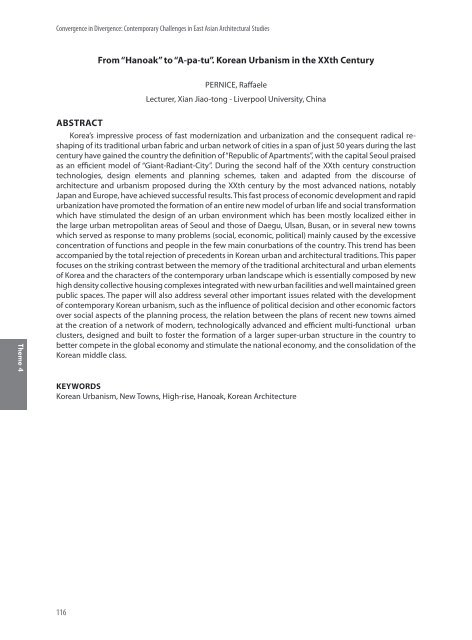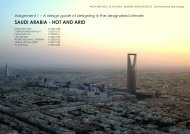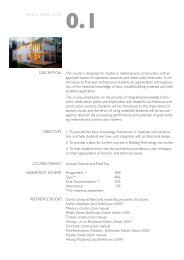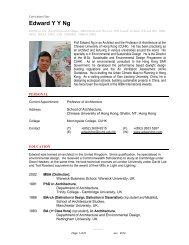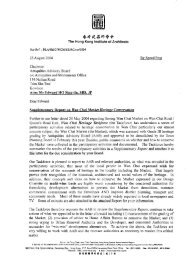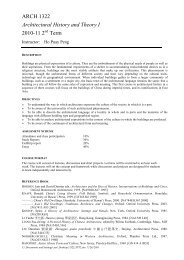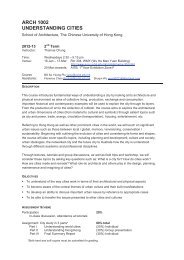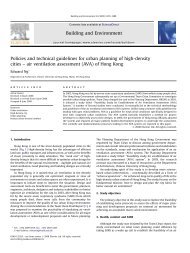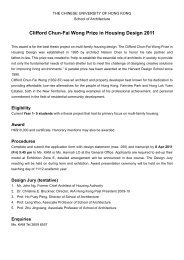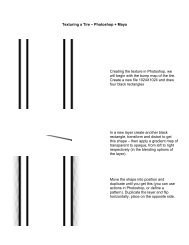CONVERGENCE in DIVERGENCE - School of Architecture - The ...
CONVERGENCE in DIVERGENCE - School of Architecture - The ...
CONVERGENCE in DIVERGENCE - School of Architecture - The ...
Create successful ePaper yourself
Turn your PDF publications into a flip-book with our unique Google optimized e-Paper software.
Convergence <strong>in</strong> Divergence: Contemporary Challenges <strong>in</strong> East Asian Architectural Studies2012 International Conference on East Asian Architectural Culture, Hong KongFrom “Hanoak” to “A-pa-tu”. Korean Urbanism <strong>in</strong> the XXth CenturyNew Forms <strong>of</strong> Growth: <strong>The</strong> Re-urbanization <strong>of</strong> the Central Districts <strong>of</strong> TokyoPERNICE, RaffaelePOMPILI, MarcoLecturer, Xian Jiao-tong - Liverpool University, Ch<strong>in</strong>aLecturer, University <strong>of</strong> New South Wales, Australia<strong>The</strong>me 4ABSTRACTKorea’s impressive process <strong>of</strong> fast modernization and urbanization and the consequent radical reshap<strong>in</strong>g<strong>of</strong> its traditional urban fabric and urban network <strong>of</strong> cities <strong>in</strong> a span <strong>of</strong> just 50 years dur<strong>in</strong>g the lastcentury have ga<strong>in</strong>ed the country the def<strong>in</strong>ition <strong>of</strong> “Republic <strong>of</strong> Apartments”, with the capital Seoul praisedas an efficient model <strong>of</strong> “Giant-Radiant-City”. Dur<strong>in</strong>g the second half <strong>of</strong> the XXth century constructiontechnologies, design elements and plann<strong>in</strong>g schemes, taken and adapted from the discourse <strong>of</strong>architecture and urbanism proposed dur<strong>in</strong>g the XXth century by the most advanced nations, notablyJapan and Europe, have achieved successful results. This fast process <strong>of</strong> economic development and rapidurbanization have promoted the formation <strong>of</strong> an entire new model <strong>of</strong> urban life and social transformationwhich have stimulated the design <strong>of</strong> an urban environment which has been mostly localized either <strong>in</strong>the large urban metropolitan areas <strong>of</strong> Seoul and those <strong>of</strong> Daegu, Ulsan, Busan, or <strong>in</strong> several new townswhich served as response to many problems (social, economic, political) ma<strong>in</strong>ly caused by the excessiveconcentration <strong>of</strong> functions and people <strong>in</strong> the few ma<strong>in</strong> conurbations <strong>of</strong> the country. This trend has beenaccompanied by the total rejection <strong>of</strong> precedents <strong>in</strong> Korean urban and architectural traditions. This paperfocuses on the strik<strong>in</strong>g contrast between the memory <strong>of</strong> the traditional architectural and urban elements<strong>of</strong> Korea and the characters <strong>of</strong> the contemporary urban landscape which is essentially composed by newhigh density collective hous<strong>in</strong>g complexes <strong>in</strong>tegrated with new urban facilities and well ma<strong>in</strong>ta<strong>in</strong>ed greenpublic spaces. <strong>The</strong> paper will also address several other important issues related with the development<strong>of</strong> contemporary Korean urbanism, such as the <strong>in</strong>fluence <strong>of</strong> political decision and other economic factorsover social aspects <strong>of</strong> the plann<strong>in</strong>g process, the relation between the plans <strong>of</strong> recent new towns aimedat the creation <strong>of</strong> a network <strong>of</strong> modern, technologically advanced and efficient multi-functional urbanclusters, designed and built to foster the formation <strong>of</strong> a larger super-urban structure <strong>in</strong> the country tobetter compete <strong>in</strong> the global economy and stimulate the national economy, and the consolidation <strong>of</strong> theKorean middle class.KEYWORDSKorean Urbanism, New Towns, High-rise, Hanoak, Korean <strong>Architecture</strong>ABSTRACT<strong>The</strong> significant scale <strong>of</strong> economic, political, social and cultural transformations that have taken place<strong>in</strong> Asia <strong>in</strong> the past few decades is reflected <strong>in</strong> an as much as significant series <strong>of</strong> urban phenomena. Incontrast to a process <strong>of</strong> contraction characteriz<strong>in</strong>g most cities <strong>in</strong> the West, Asian cities demonstrateto have developed <strong>in</strong> the early XXI century. This, however, cannot be generalized and extended to allcountries <strong>in</strong> Asia. For example, <strong>in</strong> countries such as Ch<strong>in</strong>a and Japan urban change has shown differenttendencies. While Ch<strong>in</strong>a has experienced an unprecedented urbanization result<strong>in</strong>g <strong>in</strong> remarkable urbanexpansion and transformation, <strong>in</strong> Japan dynamics that have characterized major cities s<strong>in</strong>ce the mid 1990sseem to align with those tak<strong>in</strong>g place <strong>in</strong> Europe because <strong>of</strong> a peculiar phenomenon <strong>of</strong> urban “shr<strong>in</strong>kage”(P. Oswalt:2006; H. Ohno:2008). This depicts an ambivalent scenario encompass<strong>in</strong>g the two extremeconditions <strong>of</strong> growth and decl<strong>in</strong>e. As part <strong>of</strong> a project aim<strong>in</strong>g to explore the response <strong>of</strong> urbanism andarchitecture to these conditions <strong>in</strong> the context <strong>of</strong> the cities <strong>of</strong> the East Asian Region, this paper will discussthe <strong>in</strong>stance <strong>of</strong> Tokyo, a city that shr<strong>in</strong>ks and grows at the same time. In particular, the discussion will focuson the urban and architectural forms result<strong>in</strong>g from the process <strong>of</strong> re-urbanization <strong>of</strong> the city’s centraldistricts. <strong>The</strong> paper will conclude by highlight<strong>in</strong>g the underly<strong>in</strong>g typological approach <strong>in</strong> the structur<strong>in</strong>gand <strong>in</strong> the reconfiguration <strong>of</strong> these areas.KEYWORDSTokyo, Re-urbanization, Shr<strong>in</strong>kage, <strong>Architecture</strong>, Urban Design<strong>Architecture</strong> <strong>in</strong>Projection116 117


